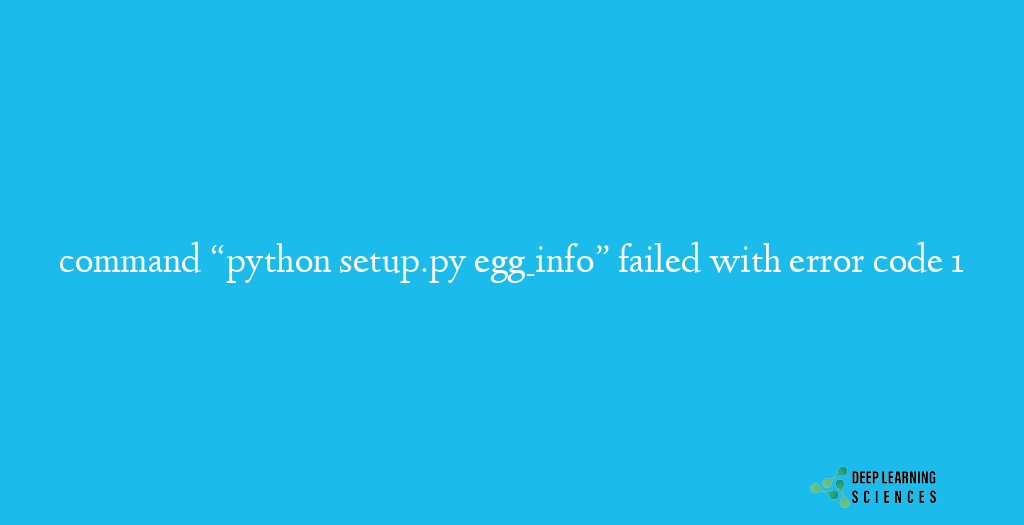When working with Python packages or libraries, you may come across an error message that says “python setup.py egg_info” failed with error code 1. This error can be frustrating, but don’t worry; in this article, we will explore the causes of this error and provide you with step-by-step troubleshooting solutions to fix it.

The error message “python setup.py egg_info” failed with error code 1 typically occurs during a Python package’s installation or setup process. It indicates that there is an issue with the package’s setup script, preventing it from generating the necessary metadata for installation.
Causes of the Error
Several factors can contribute to the occurrence of this error. Some common causes include:
- Missing or incompatible Python installation: Ensure you have Python installed correctly and that the version is compatible with the package you are trying to install.
- Incomplete or outdated setuptools installation: Setuptools is a package that facilitates the installation and management of Python packages. Make sure setuptools is installed and up to date.
- Missing dependencies: Some packages require additional dependencies to be installed. Check if the package you are working with has any specific requirements and ensure they are met.
- Version conflicts: Conflicts between different versions of installed packages can lead to errors. Resolving these conflicts is essential for a successful installation.
- Syntax errors in the package’s setup script: Any syntax errors or typos in the setup script can cause the installation to fail.
- Outdated pip version: Pip is the package installer for Python. An outdated pip version might cause issues during the installation process.
- Environmental issues: Running the installation command in a virtual environment can help isolate and resolve any conflicts with the global Python environment.
- Community support: If all else fails, seeking help from the community, such as the package’s developers or online forums, can provide valuable insights and guidance.
How To Fix Command “python setup.py egg_info” failed with error code 1
To fix the “python setup.py egg_info” failed with error code 1, follow these step-by-step troubleshooting solutions:
Step 1: Checking Python Installation
Ensure that Python is installed correctly and accessible from the command line. You can verify this by running python --version in your terminal.
Step 2: Verifying setuptools Installation
Check if setuptools is installed by running pip show setuptools in the command line. If it’s not installed, proceed to Step 3.
Step 3: Updating setuptools
Update setuptools to the latest version using the command pip install --upgrade setuptools. This ensures you have the most recent version with bug fixes and improvements.
Step 4: Checking for Missing Dependencies
Review the package’s documentation or readme file to identify any required dependencies. Install them using pip install <dependency>.
Step 5: Resolving Version Conflicts
If you encounter version conflicts between installed packages, use the command pip list
to list all installed packages and their versions. Identify conflicting packages and update or uninstall them as necessary. You can use commands like pip install <package> --upgrade or pip uninstall <package>.
Step 6: Cleaning Build Files
Sometimes, residual build files from previous installation attempts can cause issues. Clean the build directory by running python setup.py clean --all in the package’s root directory.
Step 7: Checking for Syntax Errors
Inspect the package’s setup script for any syntax errors or typos. Pay close attention to indentation, quotation marks, and variable names. Correct any errors you find.
Also Checkout: Fix TypeError: String Indices Must Be Integers in Python [Easily]
Step 8: Updating pip
Update pip to the latest version using the command pip install --upgrade pip. This ensures that you have the most recent version of the package installer.
Step 9: Running the Command in a Virtual Environment
Create a virtual environment using tools like virtualenv or venv. Activate the virtual environment and try running the installation command again within the isolated environment.
Step 10: Seeking Community Support
If you’ve exhausted all the troubleshooting steps above and are still experiencing the error, reach out to the package’s developers or consult online forums and communities dedicated to Python. They can provide guidance specific to the package and help you resolve the issue.
Conclusion
Encountering the “python setup.py egg_info” failed with error code 1 can be frustrating, but with the troubleshooting steps provided in this article, you can overcome this issue. Remember to verify your Python installation, update setuptools and pip, resolve dependencies and version conflicts, check for syntax errors, and consider running the command in a virtual environment. If needed, seek assistance from the Python community to resolve the error and successfully install the desired package.
FAQs
Why am I getting the error “python setup.py egg_info” failed with error code 1?
Q: This error commonly occurs due to issues with the package’s setup script or dependencies. Follow the troubleshooting steps outlined in this article to resolve the error.
What should I do if I encounter version conflicts between installed packages?
Identify the conflicting packages using pip list and update or uninstall them as needed. Use commands like pip install –upgrade or pip uninstall .
Is it necessary to run the installation command in a virtual environment?
Running the command in a virtual environment can help isolate the installation process and prevent conflicts with the global Python environment. It’s recommended but not always mandatory.
Where can I seek help if the troubleshooting steps don’t fix the error?
If you’re still experiencing the error after following the steps, reach out to the package’s developers or consult Python community forums and online communities for further assistance.